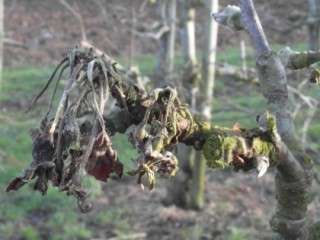
Blossom wilt is an occasional disease of dessert and culinary apples but where it occurs on very susceptible varieties such as James Grieve, Cox and Lord Derby it can cause significant losses. The disease is much more prevalent on cider apples where most commercially-grown varieties appear to be susceptible and control measures are more difficult to implement.
The fungus attacks flowers causing typical symptoms of wilting, turning brown and collapse. The lifecycle and epidemiology centres around the flower trusses and spurs.
Grey pustules of mycelium and spores develop on the affected flower parts.
The fungus progresses from infected flowers into the spur to form distinct cankers which bear grey sporing pustules in spring.
Monitor orchards of susceptible varieties for symptoms. During winter check trees for cankers with grey pustules and after blossom look for wilting dying blossoms.
Control
Effective control requires an integrated approach using both cultural and chemical control measures.
In dessert and culinary apples, routine treatments are not required every season but in cider apples routine treatments may be required each season where the disease has become established.
- In dessert and culinary orchards, cut out affected blossoms, cankers and spurs during early summer when they are easily visible.
- In the following season or following two seasons after detection apply a spray of pyraclostrobin + boscalid (Bellis) or cyprodonil + fludioxonil (Switch) at first flower and repeat 7-10 days later.
- In cider orchards pruning out infected blossoms is not possible. Where the disease is present or on very susceptible varieties (e.g. Somerset Redstreak) apply a spray of pyraclostrobin + boscalid (Bellis) or cyprodonil + fludioxonil (Switch) at first flower and repeat 7-10 days later.
- Where the disease is present at high incidence, a four spray programme, using different fungicide products, may be needed, starting at pink bud.
Fungicides approved for use on apple which offer some incidental control of blossom wilt when applied to control other diseases – efficacy factors
| Active Ingredient | Trade Name | Fungicide Group | Typh Safety | Other Diseases controlled Partly Controlled |
| boscalid + pyraclostrobin | Bellis | strobylurin (QoI + anilide | safe | Scab, mildew, storage rots, canker |
| cyprodinil + fludioxonil | Switch | anilinopyrimidine + cyanopyrrol | safe | Scab, storage rots, canker |
Fungicides approved for use on apple which offer some incidental control of blossom wilt when applied to control other diseases – safety factors
| Active ingredient | Hazards | Harvest Interval (days) | Max no. sprays | Buffer zone width (m) | ||
|---|---|---|---|---|---|---|
| Human | Fish aquatic life | life Bees | ||||
| boscalid + pyraclostrobin | h | t | u | 7 | 4 | 40 |
| cyprodinil + fludioxonil | a, c | t | u | 3 | 3 | 30 |
| d = dangerous; h = harmful; ir = irritating, a = may cause allergic reaction, t = toxic, PH = post harvest; Pre bb = pre-bud burst, sm=statutory minimum of 5 m for broadcast air assisted sprayers, u=uncategorised/unclassified/unspecified, c=closed cab required for air assisted sprayers | ||||||
Control in organic orchards
- There are no fungicides approved for use in organic systems which are effective against blossom wilt.
- Cultural methods of control are the only option at present.
- In organic production, pruning out affected blossoms and cankers is the only effective control measure.
- Where possible avoid the use of susceptible varieties in organic production.
Further reading
Blossom wilt - additional information
